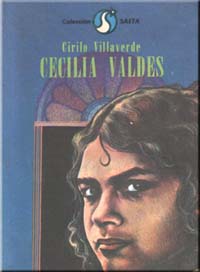2.3.3.1 The novel “Cecilia Valdés or the Angel’s Hill”, published by Cirilo Villaverde in 1882

Although Cirilo Villaverde had his first draft of the novel in the narrative work of the same name that he published in the first half of the century, the truth is that the definitive version by Cecilia Valdés was not ready until much later, published in New York in 1882. Villaverde had participated in the annexation conspiracy of Narciso López and circumstances forced him to go into exile in the United States.
Although he devoted himself as much time as possible to literature, his conspiratorial endeavors were sometimes central to his attention, and he wasn’t able to devote all these years to writing this work. He devoted only intermittent time to it, but that didn’t stop him from writing it. The work is as libertarian as his own independence struggles, as its costumbrista style didn’t stop at merely describing entities and situations taken from everyday life—masterful for the time—but aimed directly at the root of the evil: Spanish colonialism.
In the prologue, Villaverde himself indirectly qualifies the work: “I recognize that it would have been better for my work if I had written an idyll, a pastoral romance (…) but this, although more entertaining and moral, would not have been the living character, nor the description of the customs and passions of a people of flesh and blood, subject to special political and civil laws, imbued with a certain order of ideas and surrounded by real and positive influences. Far from inventing or feigning fanciful and unlikely characters and scenes, I have taken realism, as I understand it, to the point of presenting the main characters of the novel with all their details, as they say, dressed in the clothes they wore in life, most of them under their real name and surname, speaking the same language they used in the historical scenes in which they appeared, copying as much as possible (…) their physical and moral physiognomy, so that those who knew them by sight or by tradition, recognize them without difficulty and “Let them say at least: the resemblance is undeniable”
The love between Cecilia and Leonardo Gamboa, unwitting half-siblings, constitutes more than the core plot of the novel, the plane of the first reading whose curtains can be opened to reveal the stark social reality, where, from the already picturesque costumbrista picture, the most acute conflicts emerge, related to the secession of social classes and racial segregation, in addition to the very condition of women, subject to very different moral laws and much more coercive than those that were valid for men.
Cecilia’s beauty, no longer in spite of her skin pigmentation but precisely because of it, although the character herself avoids all blackness in terms of origin and destiny (she does not accept the love of José Dolores Pimienta, whom she considers inferior because of his color) and aspires to approach the white standard, already constitutes an aesthetic revel in the insular and its multiple forms of beauty, including mestizaje as a virtue; although the characters remain firmly anchored to the most intense racism, not only in the white-black dichotomy but based on the color spectrum turned into a discriminatory scale.
The work presents an interesting confluence of literary currents—as a holistic approach rather than an eclectic collection of styles—in which Romanticism and Critical Realism are most evident. The language, above all, reveals its strong Romantic influence, while the realism is present in the costumbrist details through which the author delves deeper, to show not only “the things of reality; but the reality of things.”
One of the most important novelists of the time, the Spaniard Benito Pérez Galdós, wrote to Villaverde a revealing letter to gauge the values of the work beyond the strictly national scope: “I thank you a million times for the copy you were kind enough to send me of your beautiful novel (…) I have read this work with as much pleasure as surprise, because, in truth, (I say this sincerely, hoping you will not misinterpret it, I did not believe that a Cuban would write anything so good.” The novels and the island narrative would have in Cecilia Valdés an aesthetic support of value, as well as of truly national workmanship.








